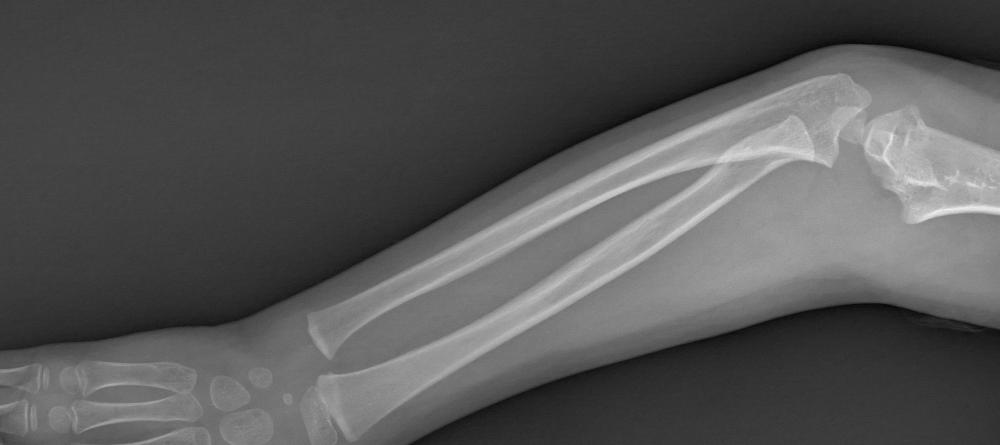At TheHealthBoard, we're committed to delivering accurate, trustworthy information. Our expert-authored content is rigorously fact-checked and sourced from credible authorities. Discover how we uphold the highest standards in providing you with reliable knowledge.
What is a Monteggia Fracture?
A Monteggia fracture is a fracture of the arm in which the ulna, one of the bones in the forearm, breaks, and the joint with the radial head at the elbow becomes dislocated. This fracture is usually very evident because it causes extreme pain and the patient's range of motion will be limited as a result of the fracture. It can be diagnosed with the assistance of x-rays to visualize the bones and joints in the arm, with the radiographer ideally taking several angles so that the full extent of the injury can be fully visualized.
Hyperextension is a common cause for a Monteggia fracture, as is a blow to the arm. There are several different subtypes of Monteggia fracture, differentiated by the precise location of the break and the nature of the dislocation. Treatment for all types is essentially the same, with the doctor making a note of the type to make sure that the arm is set properly and for future reference.

This fracture is named for Giovanni Battista Monteggia, who described it in the early 1800s. The conservative treatment is casting to immobilize the arm while the ulna and the joint have an opportunity to heal. After the arm has been in a cast for several weeks, x-rays can be taken to confirm that the bones are knitting and that the healing is even. If the bones are not healing or have been pulled out of position, the cast will need to be removed so that the situation can be corrected. For young patients, casting is often sufficient unless the fracture appears to be problematic.

For a severe Monteggia fracture, surgery may be necessary. Surgery can be used to pin the fractured ulna, and to stabilize the joint, if this is deemed necessary. This procedure is generally performed by an orthopedic surgeon, a surgical specialist who has received special training in working with injuries to the bone. After surgery, a cast is usually applied to provide stability during healing, and healing time can take six weeks or more, depending on the patient.

One concern with a Monteggia fracture is that if the healing does not go well, the arm could end up shorter than the other arm. It is also possible that poor healing could predispose the patient to another fracture, which is not desirable. Other issues which can emerge during healing include necrosis, in which bone and tissue die because they are not being supplied with blood, along with infection, which is an especially big risk with an open fracture.
AS FEATURED ON:
AS FEATURED ON:













Discussion Comments
@burcidi-- Yea, that's right. It can just be a fracture without the dislocated bone. And even with dislocated bones, there are very different ways that might happen like the article mentioned. So it's normal for the treatments to not be alike.
Some people are all better in a month or so with just a cast while others might need surgery, the placement of a plate in the arm, as well as casts, splints and braces like you did. It just depends on how bad it is.
@burcidi-- I'm sorry to hear that! That almost happened to me but thankfully I had a great doctor who took care of it.
I had a cast too, but about a week later, my doctor took another x-ray and noticed that the bone was going in the wrong direction inside the cast. So he re-set my bone in a different position and put me back in a cast. Everything went fine the second time around and I can't even tell I fractured my arm now.
My brother had an unfortunate accident where he broke his ulna bone while we were traveling abroad as a family. We had to have his arm treated there. They relocated his bone and then put it in a cast for it to heal.
We had to cast removed after a month and we had come back home by that time. When the cast was removed, the doctor was shocked to find that the bone had been relocated incorrectly and even though the fracture had healed, his forearm looked odd. The doctor said that it's too late to fix it as the bone and the joint had reattached. My brother also didn't complain of any pain and could use his arm.
So now, he's forever left with an arm that visually looks odd and slightly shorter than the other. It was just unfortunate that the accident took place while we were traveling. I didn't know before this incident that an arm fracture is so vulnerable.
Hi, is it possible to have a Monteggia fracture without the bone becoming displaced? Or do they both always happen together?
The reason I ask is because I had this happen to me a couple of years ago and my Monteggia fracture treatment included surgery, cast and splint. I even went to physical therapy for a while to get my movement back. It took months for my arm to go back to its old self.
Recently, a coworker came to work with a cast on and said that she had a Monteggia fracture. She didn't have to get surgery and she said the cast would come off pretty soon and she won't need a splint. So I'm guessing that it can just be a fracture right? Why else would the treatment for this fracture vary so much?
Post your comments